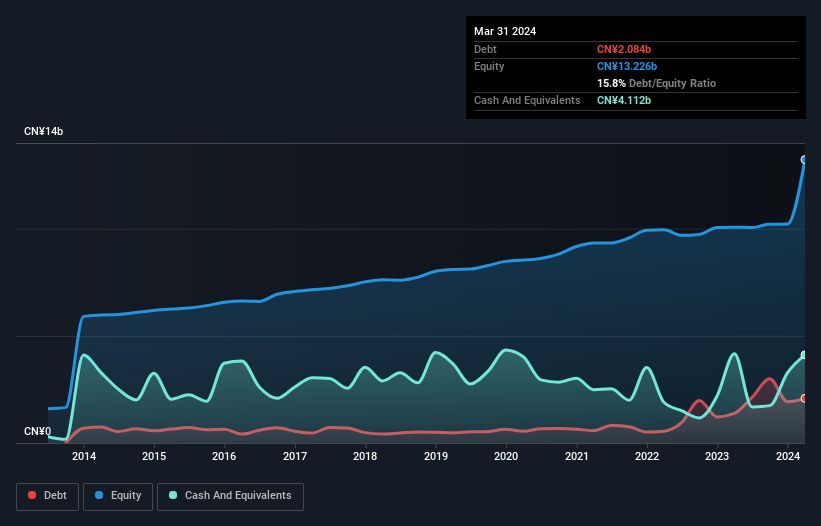- China
- /
- Aerospace & Defense
- /
- SHSE:600038
These 4 Measures Indicate That Avicopter (SHSE:600038) Is Using Debt Reasonably Well

Warren Buffett famously said, 'Volatility is far from synonymous with risk.' So it seems the smart money knows that debt - which is usually involved in bankruptcies - is a very important factor, when you assess how risky a company is. We can see that Avicopter Plc (SHSE:600038) does use debt in its business. But is this debt a concern to shareholders?
When Is Debt A Problem?
Debt is a tool to help businesses grow, but if a business is incapable of paying off its lenders, then it exists at their mercy. Ultimately, if the company can't fulfill its legal obligations to repay debt, shareholders could walk away with nothing. However, a more common (but still painful) scenario is that it has to raise new equity capital at a low price, thus permanently diluting shareholders. Of course, the upside of debt is that it often represents cheap capital, especially when it replaces dilution in a company with the ability to reinvest at high rates of return. The first step when considering a company's debt levels is to consider its cash and debt together.
Check out our latest analysis for Avicopter
What Is Avicopter's Debt?
As you can see below, at the end of March 2024, Avicopter had CN¥2.08b of debt, up from CN¥1.38b a year ago. Click the image for more detail. But it also has CN¥4.11b in cash to offset that, meaning it has CN¥2.03b net cash.

How Strong Is Avicopter's Balance Sheet?
The latest balance sheet data shows that Avicopter had liabilities of CN¥26.2b due within a year, and liabilities of CN¥3.58b falling due after that. On the other hand, it had cash of CN¥4.11b and CN¥9.90b worth of receivables due within a year. So its liabilities total CN¥15.8b more than the combination of its cash and short-term receivables.
Avicopter has a market capitalization of CN¥31.5b, so it could very likely raise cash to ameliorate its balance sheet, if the need arose. But we definitely want to keep our eyes open to indications that its debt is bringing too much risk. While it does have liabilities worth noting, Avicopter also has more cash than debt, so we're pretty confident it can manage its debt safely.
On top of that, Avicopter grew its EBIT by 95% over the last twelve months, and that growth will make it easier to handle its debt. There's no doubt that we learn most about debt from the balance sheet. But ultimately the future profitability of the business will decide if Avicopter can strengthen its balance sheet over time. So if you're focused on the future you can check out this free report showing analyst profit forecasts.
Finally, a company can only pay off debt with cold hard cash, not accounting profits. While Avicopter has net cash on its balance sheet, it's still worth taking a look at its ability to convert earnings before interest and tax (EBIT) to free cash flow, to help us understand how quickly it is building (or eroding) that cash balance. Over the last three years, Avicopter saw substantial negative free cash flow, in total. While that may be a result of expenditure for growth, it does make the debt far more risky.
Summing Up
While Avicopter does have more liabilities than liquid assets, it also has net cash of CN¥2.03b. And we liked the look of last year's 95% year-on-year EBIT growth. So we don't have any problem with Avicopter's use of debt. When analysing debt levels, the balance sheet is the obvious place to start. But ultimately, every company can contain risks that exist outside of the balance sheet. These risks can be hard to spot. Every company has them, and we've spotted 1 warning sign for Avicopter you should know about.
When all is said and done, sometimes its easier to focus on companies that don't even need debt. Readers can access a list of growth stocks with zero net debt 100% free, right now.
New: Manage All Your Stock Portfolios in One Place
We've created the ultimate portfolio companion for stock investors, and it's free.
• Connect an unlimited number of Portfolios and see your total in one currency
• Be alerted to new Warning Signs or Risks via email or mobile
• Track the Fair Value of your stocks
Have feedback on this article? Concerned about the content? Get in touch with us directly. Alternatively, email editorial-team (at) simplywallst.com.
This article by Simply Wall St is general in nature. We provide commentary based on historical data and analyst forecasts only using an unbiased methodology and our articles are not intended to be financial advice. It does not constitute a recommendation to buy or sell any stock, and does not take account of your objectives, or your financial situation. We aim to bring you long-term focused analysis driven by fundamental data. Note that our analysis may not factor in the latest price-sensitive company announcements or qualitative material. Simply Wall St has no position in any stocks mentioned.
About SHSE:600038
Avicopter
Manufactures and sells helicopters in China and internationally.
Excellent balance sheet and good value.
Market Insights
Community Narratives



